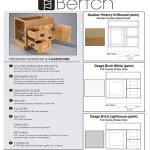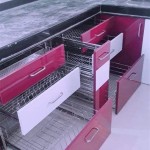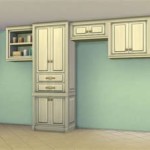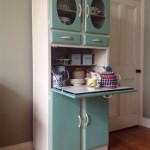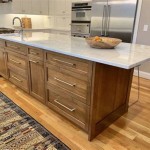How to Clean Grease Off of Kitchen Cabinets
Grease buildup on kitchen cabinets is a common problem that can make a kitchen look dingy and uninviting. Fortunately, there are several effective methods for removing grease and restoring your cabinets to their former glory. This article will guide you through the process, providing step-by-step instructions and tips for tackling this common kitchen cleaning challenge.
1. Gather Your Cleaning Supplies
Before starting the cleaning process, it is essential to gather the necessary supplies. The specific items may vary depending on the type of cabinet finish and the severity of the grease buildup. However, here is a general list of common cleaning supplies:
- Microfiber cloths: These are highly absorbent and effective at removing grease without leaving streaks.
- Soft-bristled brush: This helps loosen stubborn grease before wiping it away.
- Warm water: Essential for diluting cleaning solutions and rinsing surfaces.
- Dish soap: A mild dish soap is suitable for general grease removal on most kitchen cabinets.
- Baking soda: A natural abrasive that can help scrub away grease deposits.
- White vinegar: A natural cleaner that dissolves grease and removes odors.
- Olive oil: This can be used to polish cabinets after cleaning, especially if they have a wood finish.
It is important to note that some materials, like lacquered or painted cabinets, may be sensitive to certain cleaning products. Always test any cleaning solution on a small, inconspicuous area of the cabinet before applying it to the entire surface.
2. Prepare the Cabinets
Before you start cleaning, it's essential to prepare the cabinets to ensure a smooth and efficient process. Begin by removing any items from the cabinets and shelves, such as dishes, cookware, or decorative items. This allows for better access to the surfaces and prevents them from being accidentally damaged or contaminated.
Next, consider pre-cleaning the surfaces with a damp cloth. This helps loosen any loose debris or food particles, making it easier to remove the grease. If the cabinets have heavy grease buildup, you may need to use a soft-bristled brush to scrub away the excess grease before proceeding with the cleaning solution.
Once the cabinets are free of loose debris, you can begin cleaning the grease.
3. Cleaning Methods
The following are the most commonly used methods for cleaning grease off kitchen cabinets:
3.1 Dish Soap and Water
One of the simplest and most effective methods involves using a mild dish soap and warm water solution. Mix a small amount of dish soap with warm water in a bowl, then apply it to a clean, damp microfiber cloth. Gently wipe down the affected areas, paying particular attention to areas with heavy grease buildup. Rinse the cloth frequently with clean water and continue wiping until the grease is removed. Finally, dry the cabinets thoroughly with a clean microfiber cloth.
3.2 Baking Soda Paste
Baking soda is a natural abrasive that can be used to scrub away stubborn grease deposits. Make a paste by mixing baking soda with a small amount of warm water. Apply the paste to a soft-bristled brush and gently scrub the affected areas. Rinse the paste with warm water and wipe the cabinets dry with a clean cloth.
3.3 White Vinegar and Water Solution
White vinegar is another natural cleaner that effectively dissolves grease. Mix equal parts white vinegar and water in a spray bottle. Spray the solution onto the affected areas and let it sit for a few minutes to break down the grease. Wipe the surfaces with a damp cloth and dry thoroughly. Alternatively, you can use a microfiber cloth soaked in the vinegar solution to directly wipe down the cabinets.
3.4 Commercial Cleaners
If the grease buildup is particularly severe or if natural remedies are ineffective, you may need to consider using a commercial cleaner. Choose a cleaner specifically designed for kitchen cabinets and grease removal. Always follow the manufacturer's instructions carefully. Apply the cleaner to a clean cloth and wipe down the affected areas. Rinse the cleaner thoroughly with water and dry the cabinets completely.
Remember to always test any cleaning solution on a small, inconspicuous area of the cabinet before applying it to the entire surface to avoid damage.
4. Maintaining Clean Cabinets
To prevent future grease buildup, it is essential to maintain your kitchen cabinets regularly. Here are some tips for preventing grease accumulation:
- Wipe down spills immediately: Promptly clean spills with a damp cloth to prevent grease from setting in.
- Use a range hood: A range hood effectively captures grease particles during cooking, reducing the amount that lands on cabinets.
- Clean cabinets regularly: Regularly wipe down cabinets with a damp cloth and mild dish soap to maintain cleanliness.
- Store food properly: Store food in sealed containers to prevent grease from splattering on cabinets.
- Avoid excessive heat: Place hot pans and dishes on trivets or cooling racks to prevent heat damage to the cabinets.
By following these tips, you can keep your kitchen cabinets clean and grease-free, ensuring they remain a welcoming and inviting part of your kitchen decor.

How To Remove Grease From Kitchen Cabinets 3 Methods Bob Vila

How To Clean Sticky Grease Off Kitchen Cabinets Ovenclean

Get Grease Off Kitchen Cabinets Easy And Naturally

Best Ways To Clean Grease Stains Off Kitchen Cabinets

How To Clean Grimy Kitchen Cabinets With 2 Ingredients

Clean Kitchen Cabinets Off With These Tips And Hints

How To Clean Sticky Grease Off Kitchen Cabinets Infinity

How To Clean Kitchen Cabinets In A Few Easy Steps Hunker 2024 Cleaners Homemade House Cleaning Tips

How Remove Grease From Wood Kitchen Cabinets

How To Clean Kitchen Cabinets Everyday Skate

